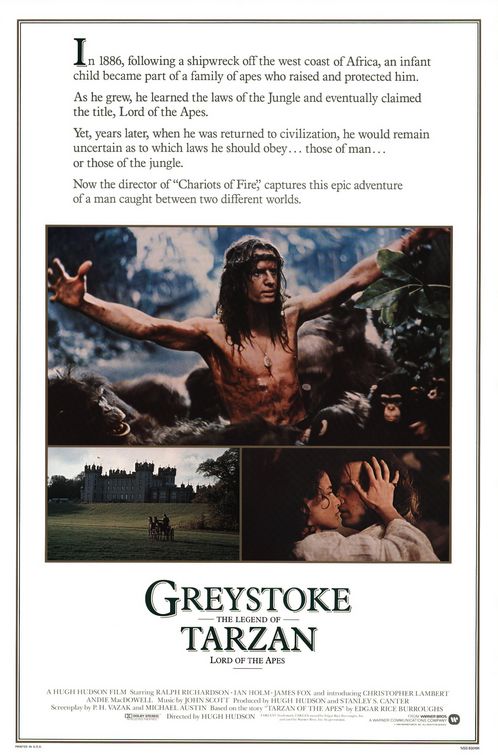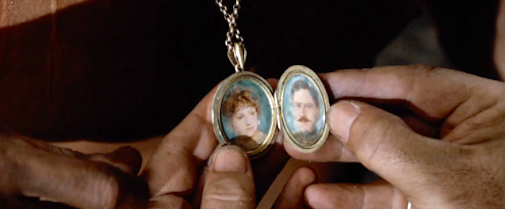 During this summer of the Tarzan reboot we've revisited past films in the long history of Tarzan on film. Four more episodes to go!
During this summer of the Tarzan reboot we've revisited past films in the long history of Tarzan on film. Four more episodes to go!
Impossible as it may be to move Tarzan away from his ultra-specific origins as a colonial era fantasy, filmmakers have tried over and over again to do exactly that. As we've seen in past installments of our "Swing, Tarzan, Swing!" series, he keeps changing with the times despite his historical baggage. We've seen starkly different depictions of his relationship to Jane from equal partners to Head of the Household suburban conformity. The Lord of the Apes even tried to get bachelor hip with the 1960s at the beginning of the James Bond frenzy. Nearly every Tarzan on television has attempted to place him closer to the actual timeline in which it aired. The new Legend of Tarzan (reviewed) works hard to downplay the racism in the myth, but it's never going completely away given that the story is, at heart, about a white man who becomes king of the jungle and often the savior of Africans in his ongoing adventures.
Tarzan works best when he's allowed to stay in the era to which he belongs. So it was a stroke of inspiration for director Hugh Hudson (fresh off a Best Picture win with Chariots of Fire) to give him the historical epic treatment in Greystoke: The Legend of Tarzan, Lord of the Apes (1984) even though the Ape Man doesn't belong to world history any more than, say, Batman, Superman and Spider-Man who were all also tragically orphaned (it's a superhero thing, okay?).

The marketing was so committed to this "serious" prestige historical treatment that the poster even has a four paragraph synopsis closer to a novel than a movie tagline...
In 1886, following a shipwreck off the west coast of Africa, an infant child became part of a family of apes who raised and protected him.
As he grew, he learned the laws of the Jungle and eventually claimed the title, Lord of the Apes.
Yet, years later, when he was returned to civilization, he would remain uncertain as to which laws he should obey...those of man... or those of the jungle.
Now the director of "Chariots of Fire," captures this epic adventure of a man caught between two different worlds."
Does it hold up in 2016? The answer, I'm happy to report, is a clear yes.
Once you acclimated to the humans in ape suits (I remember the makeup work being impressive back in the day as a youngster -- and hey, it's still better than fakey computer animation) it's easy to get lost in the world Hudson and his team have so soberly realized. Aside from one strangely superhuman moment (teenage Tarzan breaks a native's back over his head in a fit of rage over an ape killing) it's grounded in something approaching reality in ways that other Tarzan films aren't. Tarzan is strong but he's not a superhero -- sorry for the false advertising in our intro!
Despite a two hour plus running time, it doesn't drag either. By the end of the first reel, baby Tarzan has been adopted by apes and within another reel he's orphaned again. In one of the movies slyest touches, Tarzan's sustained grief yelling morphs into something far more adult and he stands erect for the first time. It's a perfect act break in the well judged screenplay which has very clear chapters.
 John Alcott's cinematography on Greystoke was nominated for a BAFTA award
John Alcott's cinematography on Greystoke was nominated for a BAFTA award
We jump forward in time to an ill advised exploratory safari (a typical Tarzan plot device that brings civilization to Tarzan) in this case that's a Belgian man Capitaine Phillippe D'Arnot (Sir Ian Holm, BAFTA nominated and wonderfully engaged with the material taking it seriously but having great fun). Phillipe's party is killed by natives and he is wounded. Hiding in a tree where he's dying from an arrow wound, he sees a backlit man emerge from the trees. I'd rank this as the single greatest entrance of the star player in Tarzan film history. Christopher Lambert had appeared in a few French films but he was largely an unknown actor when he put on the loincloth. The film made him a star and he immediately capitalized on it with starring roles opposite Isabelle Adjani (Subway, 1985) and Sean Connery (Highlander, 1986) in France and in Hollywood, respectively.
The perfect punchline to that gorgeous shot is the actual meeting. Phillipe doesn't know what to make of this jungle Jesus who is making weird animal noises at him. As he's trying to acclimate, the apes appear behind Tarzan. Phillipe does the only sensible thing to do: he faints.

Christopher Lambert has come under his share of "wooden acting" criticism in his career but I maintain that he was just terrific in this particular role, vanity-free, funny and committed to an otherworldly mix of human and animal. The scenes of him discovering and alternately rejecting or embracing his newly discovered humanity are wonderfully handled in their directness and simplicity in both direction and performance. The psychology may be broadstrokes but that's right for a Tarzan movie.
At the halfway mark of the movie, we shift genres completely and return to the civilization for something like a comedy of manners at the Greystoke estate. Here Tarzan's grandpappy waits (Sir Ralph Richardson, posthumously Oscar nominated as career tribute, having died five months before the film premiered. He also won the NYFCC prize). He's eager to meet the grandson he thought had died decades earlier.
 Sir Ralph Richardson, Oscar nominated
Sir Ralph Richardson, Oscar nominated
It's here where we also meet our Jane, the fussiest and prettiest Jane -- the Jane least likely to ever swing from vines herself --in the form of porcelain doll Andie MacDowell. But something is wrong with her vocal chords! When her lips move, Glenn Close's familar refined hauteur voice emerges. (Andie's Southern drawl was apparently a deal breaker in post-production.) I had never actually seen a Glenn Close movie at that point and it was MacDowell's debut so this was not distracting at all in 1984. Today in 2016 for the seasoned actressexual it is very distracting.
But Tarzan doesn't care because he's got his own vocal sleight of hand... uh... mouth going on as the sound mix grants Lambert perfect panther sounds in a party trick he performs for Jane. Lambert's Tarzan is both Beauty and Beast and Just Beauty Jane is clearly into it. Her stuffy would be suitor (James Fox) is hopelessly outmatched.

After Grandpa Greystoke passes, Jane & Tarzan take it to the bedroom -- excuse me, [in Glenn Close's voice "Jane's bedchamber"), mutual grief being as good as reason as any to consummate.

There are undoubtedly people in the world who found this sex scene only comic but they are wrong. It is H-O-T-N-E-S-S embodied because it's so weirdly character specific; as Tarzan gets more aroused, his monkey comes out.
In the last chapter of the film, the new Earl of Greystoke finds his worlds colliding as Tarzan realizes how shabbily mankind treats animals when a museum opens with taxidermied animals and Tarzan discovers apes in captivity. His attempts to release them end in tragedy, giving the film a potent soulful undertow after two hours of enjoying a more typical "adventure" and fish-out-of-water story. Tarzan's heart will always be in the jungle. His body must also return.

Greystoke's emphasis on Tarzan's relationship to nature and his embrace of his animal side, gave the film both a unique character among Tarzan movies and provided an unexpected bonus gift: this angle helps Greystoke sidestep most of the uncomfortable racial landmines these movies often trip upon when we see them with modern eyes. The result in 1984 was the most acclaimed Tarzan film ever, free of the prejudices, conscious or otherwise, that often greet B movies and genre films. It was a box office success and received three Oscar nominations. That's three more than all other live action Tarzan films combined. And in 2016, this still feels like a happy deserved ending for the best Tarzan film in our lifetimes.
As the credits rolled I was as happy to have returned to Greystoke as Tarzan was to the jungle, though one single mystery from the film still haunts 32 years later: Why does Phillipe teach Tarzan how to shave when the Lord of the Apes has never grown a single facial hair after 30 years in the jungle without a razor?

Next Episode: Casper Van Diem in Tarzan and the Lost City (1998)
All Chapters:
Ch. 1 Buster Crabbe in Tarzan the Fearless (1933)
Ch. 2 Johnny Weissmuller & Maureen O'Sullivan in Tarzan and His Mate (1934)
Archive Extra: Tarzan the Ape Man (1932)
Ch. 3 Lex Barker in Tarzan's Peril (1951)
Ch. 4 Gordon Scott in Tarzan's Great Adventure (1959)
Ch. 5 Mike Henry in Tarzan and The Valley of Gold (1966)
Ch. 6 Bo Derek & Miles O'Keeffe in Tarzan the Ape Man (1980)
Ch. 7 Oscar loves Greystoke, The Legend of Tarzan: Lord of the Apes (1984)